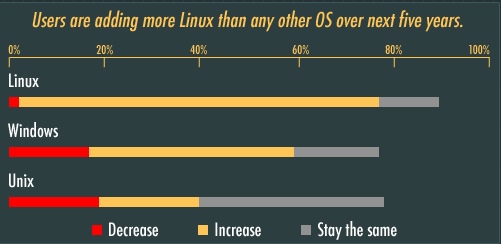
The Linux Foundation recently conducted a survey to identify just how popular Linux is in the enterprise computing world. Traditional studies of OS popularity conducted by traditional analyst firms usually only count number of units sold. But with a free operating system you can’t reliably count units sold or installed. Instead, you need to ask a different set of questions, like “Are you replacing any of your current server operating systems?” or “What operating system are you using for brand new deployments?” The results of the survey are interesting, as evidenced by the graphic above. Click it for the full infographic.
You can read the entire Linux Adoption Trends report, but here are some interesting bullet points for your consideration:
- 79.4 percent of companies are adding more Linux relative to other operating systems in the next five years.
- More people are reporting that their Linux deployments are migrations from Windows than any other platform, including Unix migrations. 66 percent of users surveyed say that their Linux deployments are brand new (“Greenfield”) deployments.
- Among the early adopters who are operating in cloud environments, 70.3 percent use Linux as their primary platform, while only 18.3 percent use Windows.
- 60.2 percent of respondents say they will use Linux for more mission-critical workloads over the next 12 months.
- 86.5 percent of respondents report that Linux is improving and 58.4 percent say their CIOs see Linux as more strategic to the organization as compared to three years ago.
- Drivers for Linux adoption extend beyond cost: technical superiority is the primary driver, followed by cost and then security.
- The growth in Linux, as demonstrated by this report, is leading companies to increasingly seek Linux IT professionals, with 38.3 percent of respondents citing a lack of Linux talent as one of their main concerns related to the platform.
- Users participate in Linux development in three primary ways: testing and submitting bugs (37.5%), working with vendors (30.7%) and participating in The Linux Foundation activities (26.0%).
Of particular interest to me was the fact that technical superiority, rather that cost, was the primary driver for Linux adoption. The low rate of migration from Unix to Linux is not particularly surprising: I’d wager that many organizations have already made big migrations for old Unix systems to Linux replacements, so what’s left is the really funky proprietary systems that are not easily migrated.
That last bullet point hit home for me, too. I recently installed the latest version of Ubuntu, and within hours of completing the installation I had filed two bug reports.
I suppose it’s a fair criticism of this report that the survey participants were all already using Linux. It might be interesting to try to conduct a follow-up survey with organizations not currently using Linux but who may consider it.